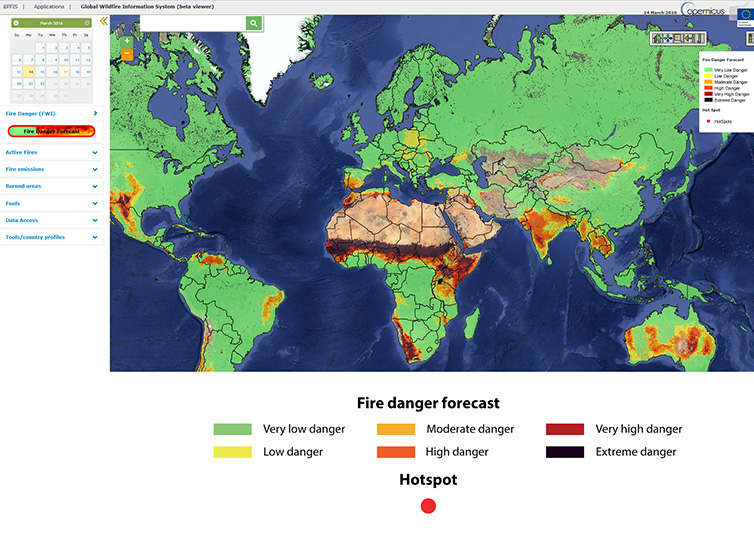
Francesca Di Giuseppe, Scientist, Forecast Department
In recent years I have been helping to develop the fire danger modelling infrastructure at ECMWF and we have recently been awarded the contract for operational provision of fire forecasts for the European Union's Copernicus Emergency Management Service (CEMS). Here I discuss some of the unique challenges involved in predicting this potentially devastating hazard.
Forecasting wildfires is a complex task as they depend on a completely unpredictable component: the way they start or “the ignition”. Fires can start naturally, triggered for example by lightning or through self-combustion (caused by natural heat-generating processes). However, ignition can also be due to human behaviour: through intentional acts for forest management (or arson) or simply through negligence. Quite commonly fires are used to encourage regeneration and biodiversity in the forest ecosystem or to replace forest vegetation with agricultural crops. Once a fire is ignited, its spread, sustainability, and difficulty of control is almost exclusively determined by weather conditions. Flames tend to rage out of control if certain soil and atmospheric conditions are met, for example as a consequence of extended drought or favourable wind conditions.
Wildfire prediction systems, used in forest management, are designed to highlight weather conditions favourable to burning, rather than attempting to predict ignition itself. Therefore, the prediction of this hazard is like no other as it is inherently stochastic. In many cases, no fire events occur, even when the forecast accurately predicts that conditions are highly favourable. Clearly this peculiarity of fire prediction poses big challenges to the interpretation of model output and the verification of model accuracy.
The decision of Europe to rely on weather forecasts
Traditionally forestry agencies have relied on observations of weather and vegetation to assess fire danger conditions, using for example the Fire Weather Index (FWI). However, by using predicted conditions from advanced numerical weather prediction models, much longer-range assessments can be achieved (for example 1 to 2 weeks in advance), enabling better planning and resource sharing within and between countries.
Since 1998, the European Forest Fire Information System (EFFIS) has been the European focal point of information on forest fires. EFFIS was established to support the national authorities responsible for management of forest fires in the European Union and neighbouring countries, as well as to provide the European Commission and the European Parliament with reliable information on trends associated with these incidents.
In recent years EFFIS has been incorporated into one of the services provided by CEMS and at the same time is expanding into the Global Wildfire Information System (GWIS), which aims to create an integrated system that provides access to all available fire-related information on a global scale. One important aspect of the European approach to fire management was the decision from a very early stage to rely exclusively on weather forecasts to calculate fire danger. This strategy has been recognised as opening up new possibilities for better international planning and coordination.
ECMWF produces some of the best weather forecasts in the world and you could say that marrying this skill with fire forecasts was a development “written in the stars”. After a preliminary trial service, ECMWF was awarded the operational provision of fire forecasts for CEMS in 2017, which will be undertaken in collaboration with Météo-France. This makes ECMWF the computational centre for both CEMS-fire and CEMS-flood.

The Global Wildfire Information System (GWIS) web interface showing the high-resolution ECMWF forecast.
Is fire danger prediction good enough?
In the last year some European countries, such as Portugal, have started using our forecast products on an experimental basis. When a catastrophic forest fire in Portugal claimed more than 60 lives this summer, we asked the Instituto Português do Mar e da Atmosfera (IPMA) (the information provider for weather-related hazards to the Portuguese civil protection agency) how good our forecast was.
According to IPMA, the fire forecast products provided by ECMWF indicated the presence of extreme fire danger conditions in the area several days in advance and they contributed to better planning and a fast response. However, from IPMA’s experience we know that FWI forecast skill usually degrades rapidly after 3/4 days. For accurate information to be available at least five to seven days ahead would be a real breakthrough enabling much improved decision management.
Next steps in fire danger prediction…
Of course, the use of weather forecasts instead of observations means that FWI values might be affected by model biases, which may be amplified or damped by nonlinear transformations in the fire model. For example, a dry bias in the model in a certain region will lead to the persistent prediction of relatively high fire danger values. If warning levels are defined on the basis of local observations (as they are in the Portuguese system), this may result in a high false alarm rate.
Good post-processing tools could minimise these errors by, for example, defining “model-based” warning levels. To support the use of fire forecast data, ECMWF has developed a freely available post-processing tool called CaliVer (Calibration and Verification) to define warning levels from model outputs. Results for the June wildfires in Portugal show, for example, that by using tailored warning levels, the ECMWF forecast predicted very high to extreme fire danger for 18 June 2017 ten days ahead of the event. This suggests that longer-range predictability can be achieved by comparing fire danger classes rather than model output values.
Another interesting aspect to explore is the use of more probabilistic information. In weather forecasting we are used to thinking in terms of probability of exceedance of a certain threshold, more than an actual value. For example, it is very common to provide information about the probability of precipitation amount going above a dangerous level. The quantification of forecast uncertainties through the use of ensemble predictions is something still pretty new in fire forecasting and it is an aspect where ECMWF's 25 years of experience could add a relevant contribution.
What next?
In the last few years, I have been quite busy building the ECMWF fire danger modelling infrastructure. Now this is in place, I would like to fully exploit the system potential and start to investigate the feedbacks that fires have on weather. Large fire events, that are typical in South East Asia during a strong El Niño year, emit so much aerosol into the atmosphere (see the animation below), that they are able to change the local and maybe even the planetary weather. Simulations of fire emissions are already produced at ECMWF as part of the CAMS activities and would constitute the natural starting point for this activity. So, up to now I have explored the fire potential from the weather conditions, perhaps the time has come to understand the changes in weather that result from fires.
Continuous smoke from the Indonesian fires in 2015. The animation shows the estimated aerosol optical depth from fires detected from MODIS sensors. The simulation is performed using a concatenation of 24-hour forecasts with the ECMWF model in the configuration used for the Copernicus Atmosphere Monitoring Service.
Banner photo: © ruig/iStock/Thinkstock
